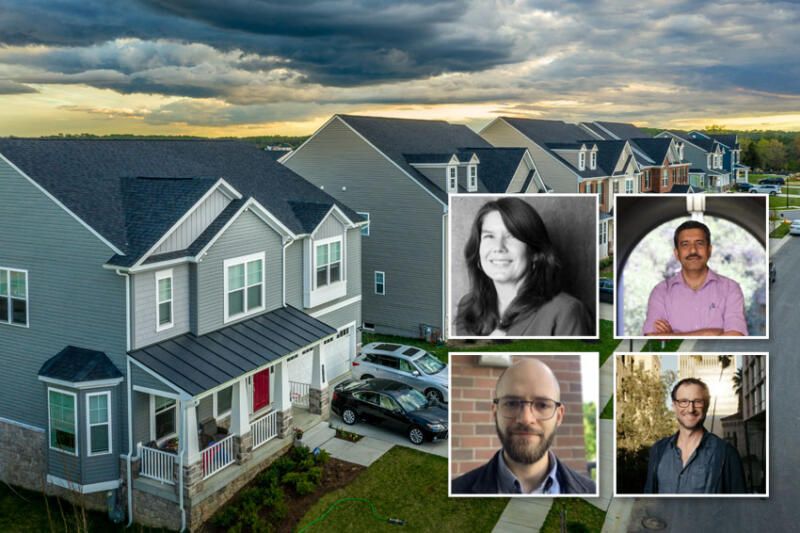California: A Housing Nightmare
(Above, Inset: Clockwise from top left): Carolina Reid, Associate Professor in the Department of City and Regional Planning and the Faculty Research Advisor for the Terner Center for Housing Innovation, Samir Gambhir, Geographic Information Systems (GIS) researcher and manager of Opportunity Mapping program at the Othering & Belonging Institute, Ned Resnikoff, Policy Manager of the Benioff Homelessness and Housing Initiative, and Matthew Lewis, Communications Director at California YIMBY. (Siliconeer/EMS)
“Housing supply and affordability crisis of historic proportions.” A narrative we have been accustomed to as California residents. In a press briefing hosted by EMS, Sept. 14, panelists discuss the impact of COVID-19 on California housing, restrictive zoning laws preventing affordable and sustainable housing, and increasing homelessness. Expert panelists include Carolina Reed of the Turner Center for Housing Innovation; Samir Gambhir with the Othering and Belonging Institute; Ned Reznikov of the Benioff Homelessness and Housing Initiative at UCSF; and Matthew Lewis, Communications Director at California YIMBY, Yes in my Backyard.
The Golden State once known as the area of opportunity now deals with a housing crisis of the decade. The crisis is ultimately driven by exclusionary zoning limiting housing supply, racial discrimination, and rising income inequality, especially in the Bay Area. The COVID-19 pandemic exacerbated the problem exponentially.
According to Carolina Reed, “If relief doesn’t hit these households by the end of the month we are likely to see an increase in evictions.” This statement comes at an opportune time as CDC eviction moratorium ends and statewide eviction moratorium also comes to an end. The silver lining is the upcoming funding from the state and, hopefully, federal level will allow for housing assistance for lower income families.
Restrictive zoning was the key issue discussed by all experts as being the culprit in exacerbating the housing crisis in the state. Experts also pointed out segregation as a key factor in the housing crisis. According to Samir Gambhir, “Increase in racial and ethnic diversity has not led to increased racial and ethnic integration. more than 80 percent of our metro regions in the nation were more segregated as of 2019 than those were in 1990.”
Gambhir points out that segregation can be detrimental for well-being and upward mobility of society. “We found that schools in communities with low levels of single family had twice their population utilizing free or reduced price lunch compared to higher single family community zone communities. Likewise, students in high single family zone studies scored nearly 15 percent higher in math and reading assessments in fourth grade. We see similar trends in graduation rates as well in high schools.”
On the topic of communities in single-family zoned housing, Gambhir says, “these cities have higher income, higher home values, better performing schools, and our evidence indicates that they are high opportunity in the broadest sense. children who were raised in these areas 30 years ago still have better outcomes in their adulthood.”
Gambhir concludes, “Opportunity is really important where we live actually determines our life outcomes: access to jobs, access to school, access to safe neighborhoods – all these are determined by where we live so it’s important that these areas which are like high opportunity or where their resources are being hoarded are opened up to other communities so that they can also access the richness diversity and the opportunity that’s available to other folks.”
According to Ned Reznikov, “the number one driver of homelessness in california and elsewhere is housing unaffordability.”
Identifying the shortage of housing, he points out California is not building enough to keep up with the population growth in the state. The increase in tech jobs and population has also brought forth income equality.
“…the wealthiest residents of that area will essentially bid up the cost of housing for everyone else because they’ll be competing with lower income residents for housing and they can just spend the money to uh win bidding wars every single time and that’s essentially what’s happened in the bay area over the past the past few decades economic inequality has increased significantly in the bay area as a result of the tech boom and at the same time housing development has stagnated and so you’ve created a dynamic where homes sell above asking price now.”
Reznikov highlights solutions in his talk. “One is to just make it easier to build more housing in California extremely low income housing… because that’s really how you help people who are at imminent risk of homelessness.”
“Two-way equation where housing needs to be cheaper and people just need to have higher incomes in order to afford rent or afford housing… If someone is both unhoused and struggling with uh substance use disorder it’s much easier to treat the substance use disorder if they are housed rather than trying to treat the disorder and then making sobriety a precondition for housing.”
Matthew Lewis shares his experience living in a non-zoned area. “I live in a single-family house. Across the street from me is a very low-income affordable housing project with eight units. Three doors down are a handful of duplexes and four-plexes and at the end of the block are multiple uh section eight apartment units each of which have about between 12 and 20 homes in them. This is all on my block in Berkeley… I’m here to tell you my neighborhood is great it’s it’s very diverse. There’s a broad mix of incomes it’s a lovely place to live and I think that this is something that’s important to help folks understand.”
As of September 17, 2021, Governor Gavin Newsom signed in two major bills, SB-9 and SB-10 that will end single-home zoning and allow for increased housing supply in California.


